|
FAQs about Sea Slugs, the
Opisthobranchs,
Identification
4
Related Articles: Sea Slugs, Nudibranchs,
Related FAQs: Seaslug
Identification 1, Seaslug ID 2,
Seaslug ID 3, Seaslug ID , Seaslugs 1, Seaslugs 2, & FAQs
on: Seaslug
Behavior, Seaslug
Compatibility, Seaslug
Selection, Seaslug Systems,
Seaslug Feeding, Seaslug Disease, Seaslug Reproduction, & Marine Snails 1, Marine Snails 2, Marine Snails 3, Nudibranchs, Nudibranchs 2, Nudibranch Identification, Nudibranch Behavior, Nudibranch Compatibility, Nudibranch Selection, Nudibranch Systems, Nudibranch Feeding, Nudibranch Disease, Nudibranch Reproduction, Berghia Nudibranchs, Snail ID 1, Snail
ID 2, Snail ID
3,
|
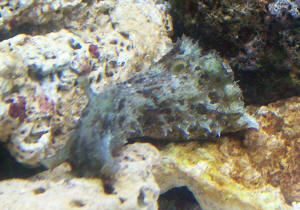
|
|
Identification please
1/31/17
<Appears to be a SeaSlug (Opisthobranch) of some sort... need to see entire
organism. Bob Fenner>
Hi it was suggested to me to ask if you would identify this creature that has
suddenly appeared in my Marine tank. I have asked on a couple of groups I'm on
but no one seems to know what it is. The last suggestion was a sea hare, but
personally I don't think it is. I have attached a photo.
Thank you
Daphne
|
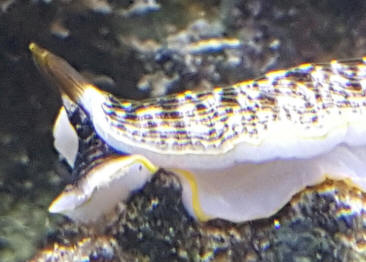 |
|
re: Identification please
1/31/17
Here are more pics
<Strange.... the sensory processes on the head don't look like rhinophores (of
Nudis), but the girdling underneath the body does.... and the animal lacks
dorsal "gills". What are does your live rock hail from? What else with hard
structure have you added recently (the last few mo.s)? I've scanned my sea slug
ref.s, and the Net and don't see this Gastropod. Oh, and about how big is it?
Bob Fenner>
|
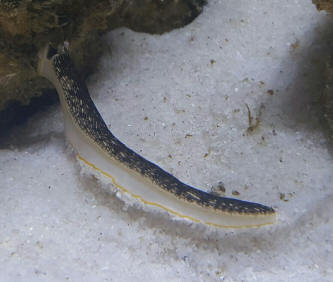
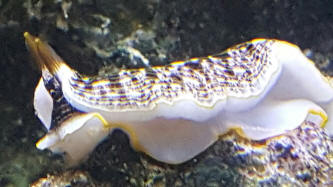 |
|
Re: Identification please 2/1/17
Hi Bob
<Hey Daphne>
The main rock wasn't live, we opted for bleached rock as we had lost everything
when our tank crashed. The only live rock I guess would be when we have bought
corals,
<Yes>
we have recently had a sun coral from our lps which had been fragged. This
hasn't done well in fact the guy from the shop said it looked like
something was eating it. Whether it's this visitor or not I don't know. As
regards size when fully stretched out I'd say he is about an inch and a half and
goes long and slim, but then he can change and get more flat and broad. He is at
the moment climbing around the glass at the front of the tank where he has been
most of the day.
<Is it possible that the gills were chewed off here? This looks more like a
Nudibranch than anything else. Am going to ask a few friends for their help. Bob
Fenner>
re: Identification please; and posted to Joe via FB
2/2/17
Thank you both Bob and Joe I will indeed remove from my tank.
<Welcome. Good>
Kind regards
Daphne
<And you, BobF>
|
|
Marine slug question
1/25/17
Hey I am wondering if you can help me identity a small yellow slug I found in my
tank there are lots of them and how I may be able to contain them.
Sent from my iPhone
<Can you crop, optimize and re-send, or make better pix... of a total of a few
hundred Kbyte size? Bob Fenner>
Re: Marine slug question
1/25/17
Sorry I'm not sure I understand why you mean. Just a clearer picture or more
zoomed as well.
<Bob's on his travels to the tropics, visiting our underwater pals. But that
means viewing large image files is a chore when he's basically stuck with
Internet access marginally better than dial-up. If you can help him out by
resizing images so they're no bigger than, say, 500 kH in size, that's great.
Online tools such as this one are useful if you don't have
image editing software to hand...
http://www.picresize.com
Cheers, Neale.>
Re: Marine slug question 1/26/17
Sent from my iPhone
<? May be a Tylodina sp. as juv.s. B>
|
 |
|
Re: Marine slug question 1/28/17
Is this a parasite?
<? Nope>
If yes do you have any suggestions as how to rid them.
<See WWM re such Gastropod Compatibility. The FAQs mate. B>
Thank you very much I am truly grateful!!!
|
|
Nudibranch ID; other 1/23/16
Hello. I've attached a pic of a hitch hiker
<A nice one too!>
I just discovered with a flashlight at night while feeding my corals. It appears
to be some sort of yellow Nudibranch.
<Mmm; not to me; this looks more like a Sacoglossan...
https://en.wikipedia.org/wiki/Sacoglossa>
It stretches out to about an inch long. I have it housed in a separate container
for now. Do you have any idea which
species it is?
<Some guesses. See WWM re the group>
And do you think I should remove it from my tank?
<Mmm; likely not harmful... most shelled and shell-less members of this group of
Seaslugs are algae eaters>
It's an SPS dominated tank.
Thanks for your assistance!
Thomas
<Thank you for sharing. Bob Fenner>
|
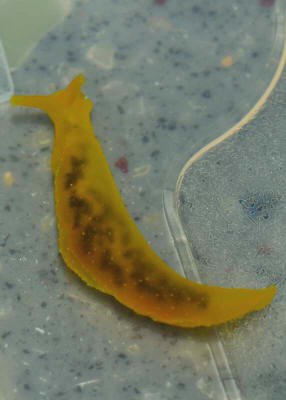 |
|
Sea slug identification
6/26/15
Hello,
I found a small sea slug last night that resemble a sea hare but haven't been
able to ID it. I looked through your sea slug identification pages and it sort
of resembles the sea slug on page 3 identified as a blue ring sea hare but I
don't see any rings on it and it looks a little more reddish brown. I have
attached some photos. Thanks in advance for you time.
Craig
<Mmm; no pix attached. Please try sending again. Bob Fenner>
Re: Sea slug identification
6/26/15
Oops sorry I forgot to attach them, here they are, it's about 1"- 1 1/2"
for reference.
Thanks,
Craig
<Yes; this may be a young Bursatella leachii. B>
|

 |
|
What is it 2/18/15
Hi Bob,
<James>
Have any idea what this is? In my son in law's tank. First thought was a
Cuke but never saw one on glass. Never saw one with "horns" either.
<Mmm, appears to be a Seahare; Anaspidean/Aplysiacea n.
Can be trouble if they "ink" in a small volume. BobF>
Thanks,
James |
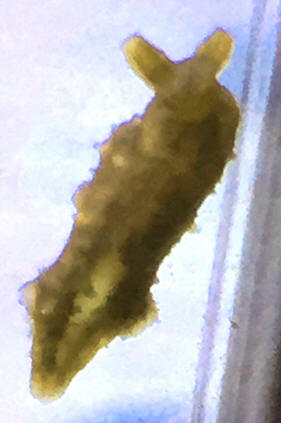 |
|
Oddball Hitchhiker – 02/20/14
About 1/2"-3/4" long and adorable to boot.
<Elysia; thanks for sharing. Bob Fenner>
|
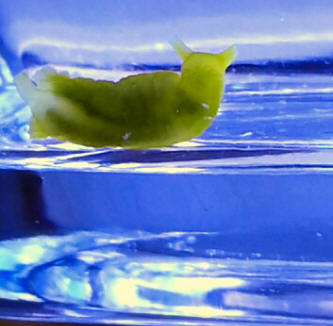
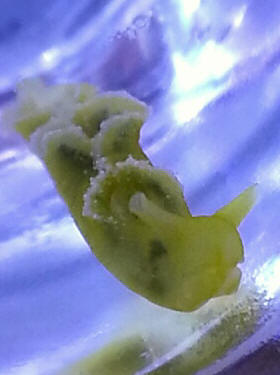 |
Re: Oddball Hitchhiker –
02/20/14
Any ideas on what it might be?
<... already stated... |
|
ID please 11/27/13
Hi guys,
<Hey Jo, where you goin' w/ that Aplysiid in your tank...?>
I wonder if you can help. A few months ago I found this little slug
which looked a bit like a Stomatella without a shell. It was only about
1cm long and as I wasn’t sure what it was, I took it out of my DT and
popped it in my QT (no medication present). He has now tripled in size
and starting to look a bit like a sea hare. He definitely has
the two sets of ‘horns’ just like a sea hare but is a bit more
flat. I think he is still growing but could you please have a look at
the photo attached? Seems to be feeding on micro algae in my QT but I
don’t want to risk putting it back in the DT as not sure what it is.
The family have become quite attached to it and my son even gave it a
name...
Many thanks and looking forward to your reply.
Jo
<I do think this is a Seahare as well... Perhaps Aplysia brasilinia, or
a Dolabella. Bob Fenner>
|
.jpg)
.jpg) |
Re: ID please
11/27/13
Wow, Bob, this was a fast reply, thanks!
Ok, Googled both suggested IDs and it looks like it might be the second -
Dolabella.
<Not uncommon... is some, your live rock from the tropical west Atlantic?>
Will do a bit more reading on its diet, etc, now I know it sort of creature
it is. A bit worrying that one site quotes max size 400mm though! I hope
not.
<That's in the wild... the general "rule of thumb" is about half for captive
specimens... Still dangerous/ly large... See WWM re... I really wish the
trade wouldn't sell Aplysiids... there ARE some quite small tropical
species; but the ones sold don't include these>
I think I will keep him in the QT for now and watch him grow, he is quite
fascinating and likes dried algae sheets.
Thanks for your help once again
Jo
<Welcome in turn. BobF>
Re: ID please 11/28/13
I just don't know where he came from as all my live rock in this tank (set
up in May) came from my old tank which has been set up since 2007!
<Mmm, well; likely something more recently put in with hard substrate>
The only thing I've added was a RBTA but again, that came on a small
branching rock
<Ahh; this is likely it>
and had been in a fellow reefer's tank for about 6 months (and I think it
was a tank split one). The slug was only tiny when I first found him.
Actually, I have also added a few bits of branching Tonga rock? I wonder if
I will end up taking it to a Marine Life Centre near us (we are in the UK)..
Off to do some more research on it
Thanks
Jo
<Do keep us informed; cheers. B> |
|
Re: Nudibranch/Sea hare ID? Sacoglossan: Elysia sp. –
2/27/13
Sorry about that. The image did not attach. Apologies with taking
so long in getting back on this.
<No worries.>
It was under a rock when I was doing a re-scape the rock had a leather
coral & some macros growing on it. Here it is.
<Thanks, I’m glad you let me know that the animal’s color was yellow not
orange! I’d have been looking everywhere for an orange-red
elysiid!>
I did not add anything in at least 6 months I do have macros in my main
display & I believe the closest match to this thing I have found is
Elysia obtusa, a Sacoglossan...or something very similar.
<Ding, ding, ding, I think you’ve got it! From what I can tell,
it’s either E. obtusa or something closely related. The only
similar species I know is one called Elysia flava, but according to
some, that’s either a synonym, or the updated name, for Elysia obtusa.
Others hold that the two are separate species, one being from the
Pacific (E. obtusa) and the other from the Atlantic and Caribbean (E.
flava). What matters is that you have a Sacoglossan sea slug in
the family Elysiidae with a taste for macroalgae, not some sort of
Nudibranch with a taste for corals! Judging from the lack of green
showing up on the “wings” (parapodia), your slug hadn’t fed for awhile,
so it may be on the way out. It’s possible though, that if you
have a large system, it may be able to find another source at perhaps
the other end of the tank. At any rate, you have a beautiful and
harmless little sea slug so enjoy it while it’s around! In the meantime,
here are a few links with more info/photos:
Elysia obtusa:
http://www.seaslugforum.net/showall/elysobtu
Elysia flava:
http://www.marinelifephotography.com/marine/mollusks/slugs/elysia-flava.htm
Elysia flava:
http://www.seaslugforum.net/showall/elysflav
Take care, -Lynn Z>
|
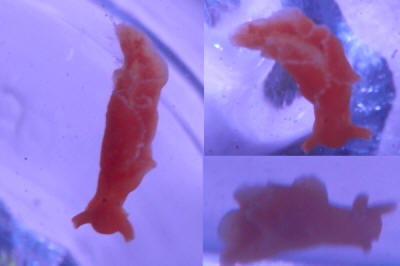 |
Nudibranch/Sea hare ID? 2/21/13
<Hello, Lynn here this evening.>
Caught this little guy in my tank tonight never saw him before. No idea
where he came from or when. It is small like the size of 1 & 1/2 grains
of rice. Best pics I could get. Is actually bright yellow not orange (
something to do with my leds & camera, I guess )slightly lighter yellow
on the edges of the "ruffles" (one on each side) on its back with two
back dots behind its head. I need to know if it is reef safe & if so
what can I do to keep it healthy.
<I don’t see any photos attached, so if you could send those along I’ll
try to get you an ID. Also, where did you see the animal?
Was it on/around a coral, sponge, anemone, etc., or on the glass,
rockwork or substrate? Finally, did you recently add anything new
(corals, live rock etc.) and if so, what type/origin? Thanks!
–Lynn Z>
|
Nudibranch Identification 10/20/11
Hello WWM Crew!
<Hello Jessica>
First let me thank you for your invaluable service. I have found
the answers to virtually all of my reef aquarium questions (and
they are plentiful!) on your site, and have you to thank for my
thriving Nano mixed reef. On to the question. I recently had my
LFS order me a lettuce slug.
Expecting to see an Elysia crispata, I was surprised when this
creature was in the bag. I called the LFS and had them check
their manifest, and he was listed as an Elysia sp., but I
don't believe it. I believe it is a Nudibranch rather than a
slug, but after much searching on SeaSlugForum, I have not been
able to identify this guy. He is about 2 inches long, and I fear
that he is not the harmless herbivore that I was hoping for. I
know many of these guys have specialized diets, so I fear for his
survival as well as that of my tank if he is toxic. He is
currently in quarantine until I figure out what he is. Your
assistance is greatly appreciated!
<Since there are a gazillion species of Nudis, I suggest going
here to find a match.
http://www.nudipixel.net/pictures/
I just do not have the time to go through all these.
Bob may have seen in the wild and/or may know and will input here
if so.>
Thanks!
<You're welcome. James (Salty Dog)>
Jessica
|
|
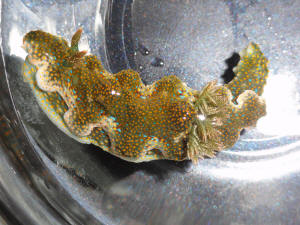
|
|
Re Nudibranch Identification 10/20/11-
10/21/22
James,
<Jessica>
Thank you for the link.
<You're welcome.>
I was able to determine that this guy is a Ceratosoma
sinuatum, a sponge-eating species of Nudibranch with no chance of
survival in my tank.
I immediately found two other references to this Nudi being sold,
as mine was, as an Elysia crispata, or lettuce slug, so I thought
it might be a service to other perplexed readers to post the ID.
The distinguishing features are the white speckles both on the
"antennae" and the feathery gill cluster on his back,
the three "humps" on his back, the tallest being
nearest to the gills, and the broad lobes edging the mantle. They
come in many color variations, but usually have a green
background with yellow and blue speckles. At least one person
reported a distressed one oozing a white discharge, so I have
some concern about toxicity. Hopefully this helps someone else
out, although it would be better if no more of these poor
creatures are mis-collected!
<Thank you for this follow up, Jessica.>
Thanks again,
<You're welcome. James (Salty Dog)>
Jessica
|
|
Nudibranch Hitchhiker ID
7/1/11
Dear WWM,
<Michele>
I have been an avid reader of your site for several years, but
this is my first time writing. I am hoping you can help me with
the identification of a hitchhiker. Please see the attached
photos. I found it in the filter sock of the sump during my
weekly water change. My best guess is that it is some kind of
Nudibranch or sea slug.
<The former>
I searched the WWM Nudibranch identification pages, and my
mystery creature seems similar to one labeled a Nudibranch in the
suborder Dendronotina, family Tritoniidae. Do you think that is
what this is?
<I do>
I have a 75 gallon reef tank. Current inhabitants are 2 Ocellaris
clowns, a yellow tang, a scarlet shrimp, a toadstool leather,
<Likely the principal food item>
a hammer coral, a torch coral, hitchhiker mushrooms, and a xenia
frag.
All inhabitants have been in the tank for 3-4 years, with the
exception of the xenia and shrimp. They were added two months
ago. Based on the tank inhabitants, do you think my hitchhiker is
friend or foe?
<The latter. I would remove these via siphoning>
Thank you for your help and the wonderful website.
Michele
<Thank you for being part of it, sharing. Bob Fenner>
|
|
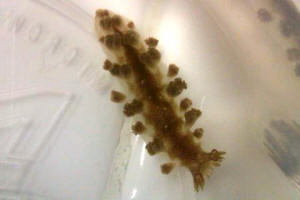 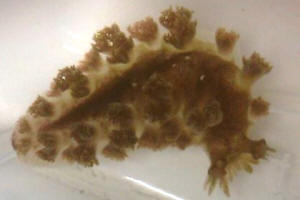
|
|
Slug ID: Hydatina zonata - 6/26/10
<Hello, Lynn here today.>
This critter is being sold as a "Bubble Shell Sea
Slug."
<Okay>
I'd like to know more about it before I purchase.
<Smart!>
A little research here and at the SeaSlugForum.net has me
wondering if it's Hydatina physis or Bullina lineata. It
doesn't look exactly like either, but there may be something
I'm missing entirely. Any ideas?
<Yep, I think it's actually Hydatina zonata, a tropical
Indo-West Pacific species which, according to Phil Rudman (of
http://www.seaslugforum.net ), is likely one highly variable
species with numerous synonyms (e.g. Hydatina
albocincta).>
Mostly, I'm concerned about its diet.
<That's understandable and again, a smart move on your
part because there is indeed cause for concern. Hydatina spp. are
specialized Polychaete/worm feeders that prey on Cirratulids, aka
'hair worms'.>
Would putting this slug in an aquarium condemn it to a slow death
because of a selective diet?
<I believe so, yes. That is, unless you could find a continual
source of Cirratulids or an acceptable substitute (please see
this link: http://www.seaslugforum.net/message/1690 ). For more
information regarding these beautiful little snails, please see
the following links:
http://shells.tricity.wsu.edu/ArcherdShellCollection/Gastropoda/Hydatinidae.html
http://www.seaslugforum.net/showall/hydazona
http://www.gastropods.com/3/Shell_983.shtml
>
Attached 4 photos.
<Nice, thank you! Hopefully the above information/links will
help, but if you have any additional questions or concerns,
please let me/us know. Take care, Lynn Z>
|
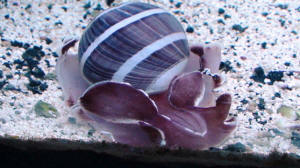 |
Loss of the Sea slug forum? 6/5/10
> I thought you should see this:
> Loss of the Sea slug forum:
> http://www.seaslugforum.net/message/23712
> Any thoughts? Would be a shame to lose such a wonderful
resource.
Bill I am saddened, and shocked with the news of the loss of your
forum. Is there any chance re redress, or has the decision to terminate
cast in concrete? A long-time user of your database and enjoyer of your
efforts, Bob Fenner, WetWebMedia.com
Bob, if this is indeed gone, how about we incorporate the info into
WWM? I love and value this forum. I for one will donate my time to do
so if this is the case and Bill et al is agreeable.
Scot V.
Mmm, I think there's more to this other than space Scott... Bill
mentions code writing, issues, and likely the time commitment to keep
the site current, respond to input and queries. As an archive of the
"flattened" database, this could be easily sponsored for ten
dollars or so a month... BobF
|
Sea Slug ID: Likely Tritoniid Nudibranch -
5/23/10
Hi Bob, et al,
<Hello Nick, Lynn here tonight.>
Had a problem with one of my corals recently,
<Uh-oh>
..lifted it up to take some photos and found these two slugs
below
<Not good>
(Please excuse the Aiptasia, that's another headache).
<Yep, they definitely can be a headache!>
I believe they are the culprits for the nasty damage to the
coral, coming out to eat it at night.
<If the damage was done to soft corals, you'd be right.
What you have looks very much like a couple of Nudibranchs in the
family Tritoniidae (Suborder: Dendronotina). Nudi's in this
family prey on soft corals, hydroids, sea pens, and Gorgonians.
I'd recommend removing any and all individuals (as well as
any egg masses) with something like a turkey baster. Quarantining
the corals would be a good idea, if possible. If not, keep
checking the corals (especially at night) and remove every Nudi
you see. Please see the following link for an example of a common
tropical specie: http://www.seaslugforum.net/showall/triteleg
>
Are you able to help with identification, and confirm they would
be eating it?
<Well, it would help to know what kind of corals were being
preyed upon, but since those look like Tritoniids, I'm
guessing they're softies. For more photos of species in this
family, please see the following link. Tritoniidae starts about
3/4 way down the page. Each species is a link to an information
page with photos. http://www.seaslugforum.net/specieslist.cfm
>
I've tried www.nudipixel.net but can't seem to find a
match.
<There are an awful lot of Nudibranchs out there!>
Many thanks for your help.
<You're very welcome.>
Regards
<Take care.>
Nick
<Lynn Z>
|
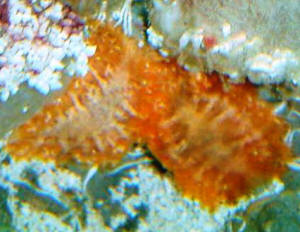 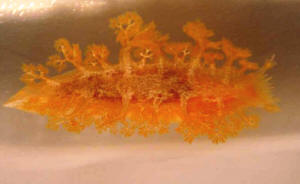 |
|
Re: Sea Slug ID: Likely Tritoniid Nudibranch, now
Nephtheid - 5/24/10
Hi Lynn,
<Hi Nick!>
Thank you so much (I must also say WWM is brilliant)
<You're very welcome and thank you!>
It is indeed a soft coral, and the only coral I currently have -
I can't remember its name now, could it be a Nephthea?
<Well, coral ID's aren't exactly my forte, but that
does indeed look like something in the family Nephtheidae (order:
Alcyonacea). Unfortunately, Tritoniids love to eat
Alcyonaceans.>
There are some photos attached if that helps.
<It certainly does, thank you.>
I wasn't sure I was able to keep corals alive in my tank, now
it looks like they might have just been eating them.
<Likely so>
I think you are right, it may have been the white vs. orange that
made me miss the pictures.
<I can certainly understand. That particular species varies
from white, to orange to a reddish orange but if you don't
know that, you can easily dismiss it as a candidate. I've
done the same thing myself a time or twenty!>
On closer inspection, it indeed looks like they have laid eggs
all over the base of the coral,
<Yikes! I'd hoped that wasn't what I was seeing in one
of the previous photos.>
I thought about using a freshwater dip, but I believe I read on
your site that the freshwater dip could kill the coral,
<Yep, corals do not like freshwater dips.>
..so will probably go with gently scrubbing them off in a bucket
of tank water.
<Sounds good. Definitely get rid of those eggs and keep an eye
out for more Nudi's.>
Regards
<Take care>
Nick
<Lynn Z>
|
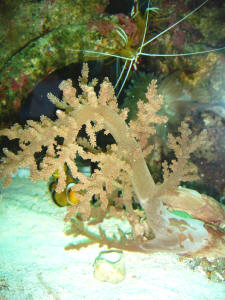 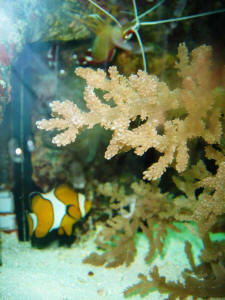 |
|
Help With A Slug ID? Likely Dendrodoris nigra or
fumata - 3/12/10
Hi WWM crew!
<Hi Adam, Lynn here today!>
I'm hoping you can help me with an ID on something that has
apparently hitchhiked its way in to my 90g reef tank.
<Surprise!>
I will attach the two best pictures I have of it in this e-mail.
I have to apologize for the iPhone photo quality but wouldn't
it be my luck that when something cool and unexpected appeared,
my big camera was sitting on my desk at work.
<Murphy's Law strikes again!>
It was about 1.5 inches long, half an inch across and looked very
much like a slug with a ruffled skirt of tissue all the way
around its body. It has two antennae
<'Rhinopohores'>
..and what looks like..a wilted flower the part of its body that
I assume is its anus or maybe gills.
<Gills>
The pictures make it look black, but under the halide lights of
my aquarium, it was the deepest royal blue I have ever seen on an
animal. It had two rows of tiny white dots down its back (I
played around with the gamma, white balance and exposure on these
pics in PS so you can see the dots) and white dots on the tips of
its antennae. I was a little shocked to see something that large
and delicate pop up unexpectedly in my tank which has been up and
running now for 6 months and my initial reaction after "wow
that's pretty" was concern, as I know that some sea
slugs/Nudibranchs can be quite dangerous in a reef aquarium.
<Yep, Nudibranchs in particular can be a real problem
sometimes.>
Last month something started eating the polyps on one of my
largest Acropora colonies in the night
<Uh-oh. Take a good look at the colony at night and watch for
the usual suspects: Asterina stars, other Nudibranchs, crabs,
coral-eating snails, a large Fireworm, flatworms, etc. Basically,
look for anything on or near the coral.>
..and I thought I had identified the culprit to be a small, hair
covered, mucous blowing crab that I removed,
<Heheee! That sounds like the person that sat behind me in
Avatar a couple of weeks ago! Seriously though, the crab could
well have been the culprit. Just keep an eye out for further
signs of predation, just in case.>
..but I didn't know I had something as odd as a sea slug in
my tank at the time. From the looks of its mouth parts which I
got a peek at when it pressed against the glass, it looks like an
algae eater but I've also heard that some sea slugs can be
quite toxic.
<Yes indeed. There's a Sea Hare/Aplysiid from around
Australia that's been responsible for quite a few dog deaths.
Apparently the dogs find them washed up on the beach, eat them,
and sadly, it's game over.>
I've been pouring through the sea slug forum species list at
http://www.seaslugforum.net/specieslist.cfm,
<Love this site>
..but I'm afraid in my totally naive state I don't even
know what family or Superfamily I should be looking in. Some
members of the Onchidorididae family appear to have the right
body shape, but I don't know how diagnostic that is.
<It all helps, believe me. By the way, kudos to you for even
beginning to look through that long list of species!>
Any suggestions on where I should be looking
<Yes, take a look at the Nudibranch species Dendrodoris nigra
and Dendrodoris fumata (Suborder: Doridina, Family:
Dendrodorididae). They're common, tropical Nudibranchs from
the Indo-West Pacific that feed exclusively on sponges and are
often mistaken for each other. Both have white-tipped rhinophores
and are mostly black as adults although they can appear bluish
under certain lighting. For more information on these two
beauties, please see the following links, starting with the FAQ
titled 'Flatworm Identification: Actually, A Nudibranch:
Dendrodoris nigra or fumata -- 2/17/10' here:
http://www.wetwebmedia.com/nudicompfaqs.htm
Dendrodoris nigra:
http://www.seaslugforum.net/showall/dendnigr
Dendrodoris fumata: http://www.seaslugforum.net/showall/dendfuma
>
..or if this is dangerous?
<It is to your resident sponges. Other than that, it
doesn't pose much threat to the system as a whole. The good
news is that it's a fairly small Nudi in a large volume of
water so any potential toxins released upon death should have
negligible impact.>
I would prefer to not remove it as it's quite beautiful,
<It is indeed.>
..but considering how long it took to find it (and believe me I
spend more time than I should staring in to my tank)
<Me too!>
..I don't even know if I'll ever see it again.
<You might not. It happens that way sometimes.>
Thanks again for your invaluable assistance,
<You're most welcome.>
Adam LeClair
<Take care, Lynn Zurik>
|
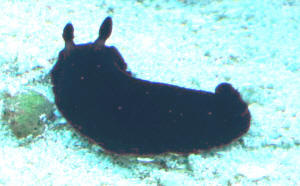 |
|
Re: Very Confused... much more
reading... 8/10/09
I've attached pictures of the Nudibranch which I believe is a
Caribbean sea hare but I am not sure?
<... not a Nudibranch, but an Aplysiid, a sea hare; Aplysia
dactylomela looks like to me>
One concern that I have is if he will ink if stressed, or
attacked?
<Might>
Although I don't think I have anything that will attack him.
He has been in there since 7/22 and seems to be doing good so
far, key words there! Thanks for the links about alkalinity and
calcium. I will check them out now.
I hope you or another crew member can positively identify my
Nudibranch so I know I am caring for him properly. Thank you very
much
Bobi
<Do search, read on WWM re... Bob Fenner>
|
 |
|
Re: Very Confused... Aplysiid ID
8/11/2009
Thank you Mr. Fenner! I will read everything I can find on him.
This little guy consumed all of our green hair algae in about 3
days and he is not really interested in the dried seaweed we
offer, so I am very afraid of him starving! I will read
everything possible but in the meantime, can you suggest a food
for him?
Thanks Bobi
<Please read where you were referred. B>
|
|
|

